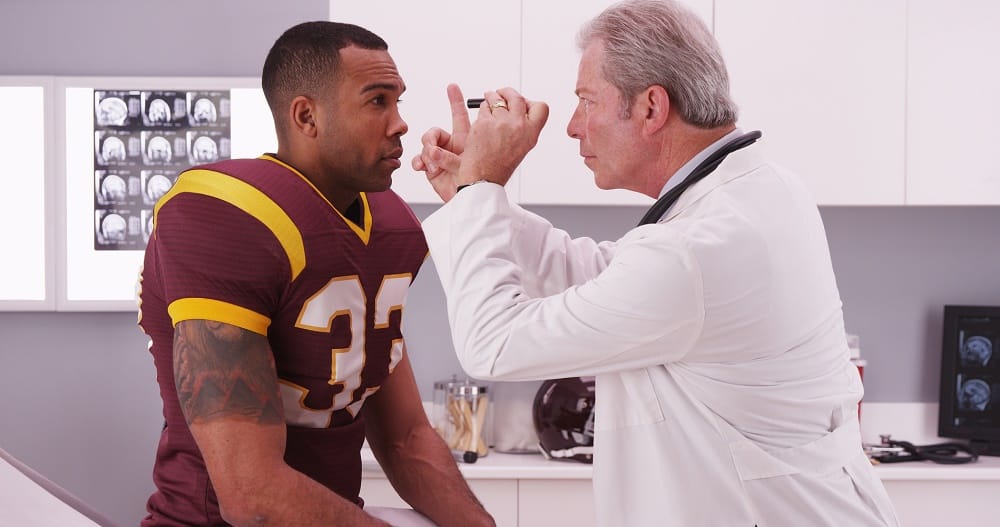Concussion Management in the Young Athlete
The word concussion is heard more in the mainstream media but what are the reasons why? Has the way we approach concussion treatment changed? Dr. Mathew Pombo, a highly regarded orthopedic surgeon with the Emory Orthopaedic surgery faculty, has brought increased awareness of concussion management and currently serves as the Director of the Emory Sports Concussion Program. Dr. Pombo agreed to answer some questions about why he became interested in concussion management and what are the current trends in treatment.
Stacy Hund (SH): You trained at the University of Pittsburgh Medical Center for your fellowship, what was the inspiration for your concentration on concussion management and intervention?
Dr. Mathew Pombo (MP): During my residency, I treated a kid who had a concussion and he was experiencing post-concussive syndrome, which presented like a kid who has ADD (attention deficit disorder). He was struggling in school and having difficulty getting into college. Prior to the concussion, he had great grades and did not have these struggles. I realized that the concussion was not just an injury but also changed his position in life. I also had a friend from high school who had many similar challenges and was kicked out of his house his senior year of high school. Concussions can truly affect the future of young athletes and with treatment we can intervene and make a change in these kids' lives. When I was in residency, concussions centers did not exist but we have come a long way and now there are several centers in the greater Atlanta area to serve the community. Also, during this time, eighty percent of athletes that had a concussion were not diagnosed but now we have programs in place to identify athletes that have sustained trauma.
SH: Has the increased press about concussions in the NFL increased the awareness of concussions for young athletes?
MP: The press, related to incidence of concussions, has increased awareness but it has also increased fear. When treating concussions, it is important to manage all aspects of care. Former NFL players that are suffering ill effects were not treated with the current algorithms that we have in place now. We are more educated regarding the management of the athlete after they have had a concussion.
SH: From a physician's perspective, what does acute concussion treatment include?
MP: First is the education of the athlete, which involves recognizing the signs and symptoms associated with a concussion, discussing the risks involved with return to play, understanding that a concussion is not just an ankle sprain and twenty percent need more active management, and having a physician manage the athlete's care. Secondly, it is important to make sure that the athlete is asymptomatic at rest and at school and then the athlete can go through an exertive sports specific program. The athlete should have neuropsychological testing to determine their status. Full recovery can take anywhere between one week and three months before an athlete is ready to return to play
SH: What multi-disciplinary recommendations do you typically share with the athlete?
MP: Concussion symptoms can be clustered into groups based on the primary symptoms. Examples of symptom clusters include a migraine cluster, vestibular/ocular cluster, gaze instability cluster and a cognitive cluster. We have learned from the research that treating concussions by limiting all activity and staying in a dark room are not effective treatment strategies and do not help with recovery. Initially there can be school modifications, such as half days in class, and limiting but not eliminating time on a smart phone or watching television. It is also important to treat anxiety, depression, and sleep dysfunction that develop as a result of the injury and to initiate therapy for vestibular and visual disorders, if necessary. There are multiple ways to treat each cluster and once the athlete's condition improves then physical exertion activities can be added into the program.
SH: Aside from football, which has stolen the "concussion spotlight", what other sports have a high incidence of concussions?
MP: Women's soccer is number two compared to football in the number of incidences of concussions per participant in the sport. Concussion management is an ever changing field and it is a balancing act of sensationalism versus science. It is important to understand that a concussion is a very treatable injury; however, we do not know how many concussions are too many before long term effects are sustained. The main goal for the athlete is to completely recover from a concussion before returning to play to decrease the risk.





